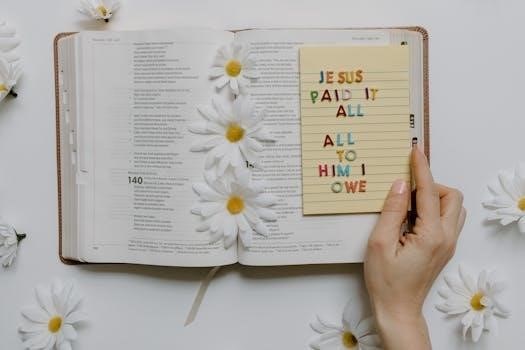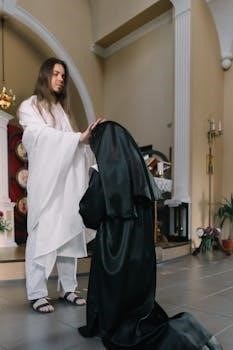seven places jesus shed his blood pdf
Discover the profound journey through the final days of Jesus’ life, exploring how He shed His blood not just once, but seven distinct times․ This powerful act of sacrifice demonstrates the extent of God’s redeeming power to save, deliver, and heal․
Overview of the Concept
The concept of Jesus shedding His blood in seven distinct places is rooted in the idea of a complete and perfect sacrifice for humanity’s redemption․ It’s believed that this seven-fold shedding corresponds to the seven ways we have sinned and rejected God, requiring a specific cleansing for each aspect of our lives․ This theory suggests that by willingly shedding His blood in these seven places, Jesus broke curses and released divine blessings․ The number seven itself signifies perfection and completeness, indicating a perfect work of salvation․ This prophetic fulfillment demonstrates the depth of Jesus’ love and the extent of His sacrifice, offering healing, deliverance, and freedom from sin and its consequences․ Each place holds significance, addressing different aspects of human brokenness and presenting a holistic path to restoration․ The blood of Jesus, therefore, becomes a powerful tool for spiritual cleansing and empowerment․

The Seven Specific Places of Bloodshed
The places where Jesus shed His blood are significant as they represent different facets of human suffering and redemption․ These seven locations highlight the completeness of His sacrifice․
Gethsemane⁚ Sweating Blood
The first place where Jesus shed His blood was in the Garden of Gethsemane․ It wasn’t from a physical wound but from the immense emotional and spiritual anguish He experienced․ The Bible describes His sweat as becoming like drops of blood, a condition known as hematidrosis․ This occurred as He wrestled with the weight of the world’s sins, anticipating the suffering to come․ It was a moment of profound distress where He demonstrated His willingness to submit to God’s will, despite the overwhelming burden He faced․ This act of obedience is a testament to His love for humanity․ This blood shed in Gethsemane represents the beginning of His sacrifice, a prelude to the physical pain that followed․ It signifies the redemption from our will․
The Whipping Post⁚ Shedding Blood on His Back

The second place Jesus shed His blood was at the whipping post․ Here, He endured brutal lashings that tore at His flesh, causing significant blood loss․ This was not just a few strikes but a savage beating with a whip designed to inflict maximum pain․ The purpose was to humiliate and weaken Him before crucifixion․ This act of violence was part of the Roman judicial process, but for Jesus, it was a deliberate act of sacrifice․ The shedding of blood from His back at the whipping post is seen as payment for our healing and deliverance․ It was a necessary part of His suffering that allowed us to be freed from the curse of sickness․ The physical agony He endured at this place was immense, but it was done out of love for us․
Internal Bleeding from Beatings
Beyond the visible wounds from the whipping, Jesus also suffered internal bleeding due to the brutal beatings He endured․ These beatings, inflicted by both Roman soldiers and others, caused unseen damage to His body․ The impact of the blows would have resulted in internal hemorrhaging and organ damage, adding to the immense suffering He experienced․ This unseen shedding of blood is often overlooked, but it was a significant part of the overall sacrifice․ It speaks to the extent of the violence He underwent and the depth of His pain․ This internal bleeding, though not outwardly visible like the blood from the whipping post or the crown of thorns, was no less significant․ It contributed to the total cost of our redemption and signifies the complete nature of His sacrifice․
Crown of Thorns⁚ Blood Shed from His Head
The crown of thorns, a cruel mockery, was pressed onto Jesus’ head, piercing His scalp and causing significant blood loss․ This act of humiliation and torture resulted in intense pain as the thorns dug into His flesh, shedding blood․ The blood from His head represents the cleansing of our thoughts, purifying our minds so that we may be open to learning how God thinks․ The thorns were not just a physical torment; they symbolized the curse of sin that Jesus willingly bore․ This shedding of blood from His head, along with the physical pain, represents a spiritual cleansing of our minds, opening the way for us to receive God’s wisdom․ The crown of thorns, therefore, is a powerful image of Christ’s sacrifice․
Blood Shed from His Hands
The piercing of Jesus’ hands with nails on the cross resulted in another shedding of blood, a significant act in the overall sacrifice․ These wounds, inflicted as He was fixed to the cross, represent the breaking of curses and the release of blessings․ The hands, which once healed and blessed others, were now pierced, symbolizing His willingness to take our sins upon Himself․ This blood shed from His hands signifies His complete submission to the Father’s will and His ultimate sacrifice for humanity․ The act of crucifixion, with nails driven through His hands, is a vivid depiction of His love․ The blood from His hands represents the power to break generational curses, and the release of blessings․
Blood Shed from His Feet
The blood that flowed from Jesus’ feet, pierced by nails upon the cross, carries profound significance within the narrative of His sacrifice․ These wounds, mirroring those in His hands, symbolize the path He willingly walked for our redemption․ The feet that once journeyed to spread the message of love and healing were now immobilized, enduring immense suffering․ This shedding of blood at His feet represents the breaking of curses and the release of blessings in our lives․ The imagery of His feet nailed to the cross emphasizes His complete and unwavering commitment to the divine plan․ The blood that flowed from His feet is a testament to the power to overcome sin and the promise of eternal life, a powerful image of His love․
Blood Shed on the Cross
The final and culminating act of Jesus’ sacrifice involved the blood shed on the cross, a profound moment of ultimate redemption․ Here, as He hung suspended between heaven and earth, the full measure of His suffering was poured out․ The blood shed on the cross represents the completion of the perfect work, fulfilling the prophetic sprinkling required to appease God․ This is the place where the curse of sin was broken and the path to salvation was opened for all humanity․ The blood that flowed from His wounds on the cross carries the power to cleanse us from all unrighteousness, offering forgiveness and the promise of reconciliation with God․ It’s the ultimate symbol of love and sacrifice․ This final shedding signifies complete victory over sin and death․

The Significance of Seven
The number seven is often associated with completeness and perfection, indicating a perfect work; It signifies the full work of the Holy Spirit and a divine fulfillment of prophetic significance․
Seven as a Number of Completeness
The recurrence of the number seven throughout the Bible underscores its symbolic importance, representing completeness and divine perfection․ This idea of completeness is particularly significant when considering the seven places where Jesus shed His blood․ It suggests that His sacrifice was not a partial or incomplete act, but a finished work that fully satisfied the requirements of divine justice․ The sevenfold shedding of blood signifies the perfect and comprehensive nature of Christ’s redemptive act․ It is a testament to the thoroughness and totality of His sacrifice, leaving no aspect of human sin or suffering untouched․ This number, therefore, highlights the completeness of the provision made for mankind’s salvation through the blood of Jesus․ Just as God rested on the seventh day, the seven places of bloodshed represent a completed work of redemption, offering rest and peace to all who believe․ This perfect work of Christ, signified by the number seven, is central to understanding the depth of His love and the power of His sacrifice․

The Impact of the Blood Shed
The blood of Jesus has immense power, bringing redemption, cleansing from sin, healing, and deliverance․ It breaks curses and releases blessings, offering a complete transformation for believers who embrace it․
Redemption and Cleansing from Sin
The shedding of Jesus’ blood in seven distinct places is a powerful act of redemption, offering complete cleansing from sin․ Each instance signifies a specific aspect of our fallen nature being addressed through His sacrifice․ This goes beyond a single act of atonement, showcasing a multifaceted approach to our spiritual healing․ The blood of Jesus is not only for forgiveness, but also for purification․ Every stain of sin, every wrong thought, and every act of disobedience is washed away by the power of His blood․ This cleansing is not temporary; it’s a permanent transformation, making us pure in God’s eyes․ Through this sacrifice, we are declared righteous, not based on our own merit, but on the merit of Christ’s perfect sacrifice․ The blood serves as a propitiation, satisfying God’s wrath against sin․ It breaks the chains of sin’s bondage, allowing us to live in freedom․ This is the ultimate demonstration of God’s love and grace;
Healing and Deliverance
The seven places where Jesus shed His blood are not just about forgiveness; they represent a comprehensive healing and deliverance for our whole being․ Each place of bloodshed corresponds to a specific area where we experience brokenness and bondage․ The blood shed at the whipping post signifies the breaking of the curse of sickness and disease․ The crown of thorns addresses the pain in our thoughts and minds․ The blood from His hands and feet speaks to the restoration of our actions and our walk in life․ The suffering that Jesus endured is our path to wholeness․ By His stripes, we are healed; by His blood, we are set free from the captivity of our past․ This healing extends beyond the physical realm; it encompasses emotional and spiritual well-being․ The blood of Jesus is a powerful weapon against the enemy․ It breaks the grip of oppression, and sets us free from fear․ Through this sacrifice, we are made whole, body, soul, and spirit․
Breaking Curses and Releasing Blessings
The intentional shedding of Jesus’ blood in seven distinct places is a powerful act that breaks every curse and releases blessings into our lives․ These seven points of sacrifice were not accidental; they were purposeful acts of love and redemption․ The blood shed was designed to reverse the effects of sin and its consequences, which often manifest as curses in our lives․ Every place that Jesus bled was a point of victory over the enemy’s attempts to keep us in bondage․ Through the blood, we are released from generational curses, sickness, poverty, and spiritual oppression․ The blood of Jesus opens the door for divine blessings to flow into our lives․ This includes healing, prosperity, peace, and a deep sense of purpose․ These blessings are not just random occurrences; they are a direct result of the sacrifice made by Jesus Christ․ His blood has purchased our freedom, allowing us to walk in the fullness of God’s promises․ It’s the key to our inheritance․
